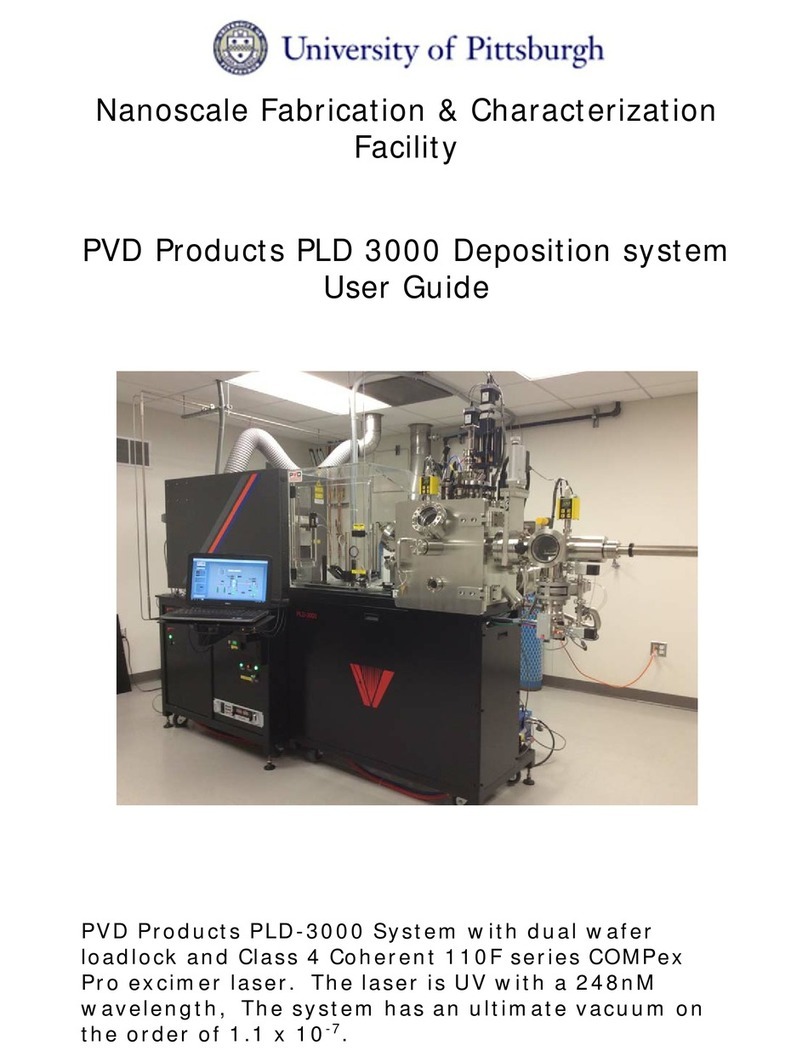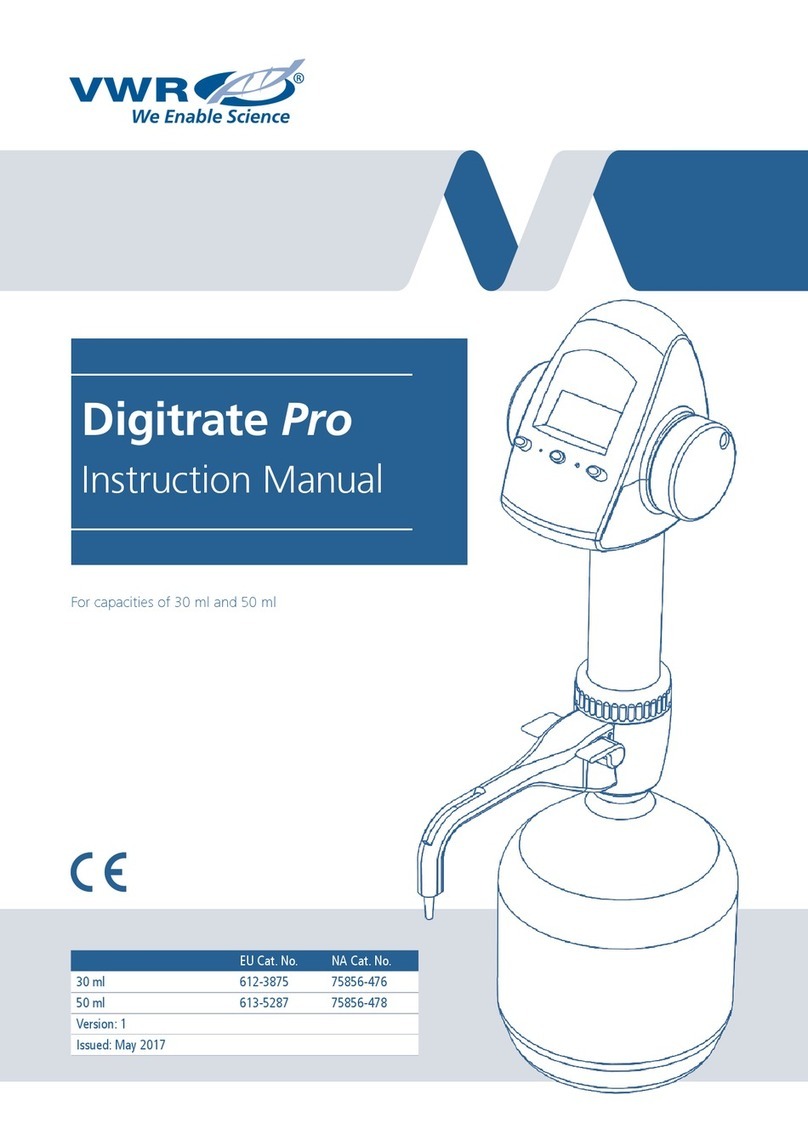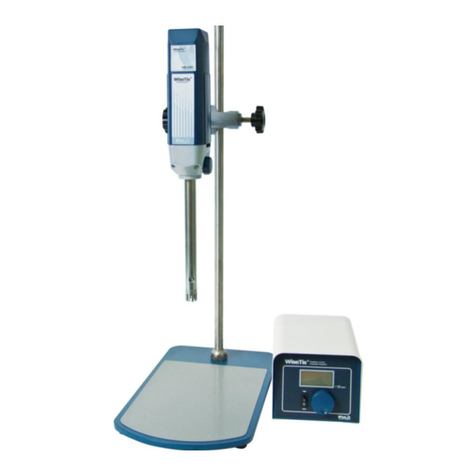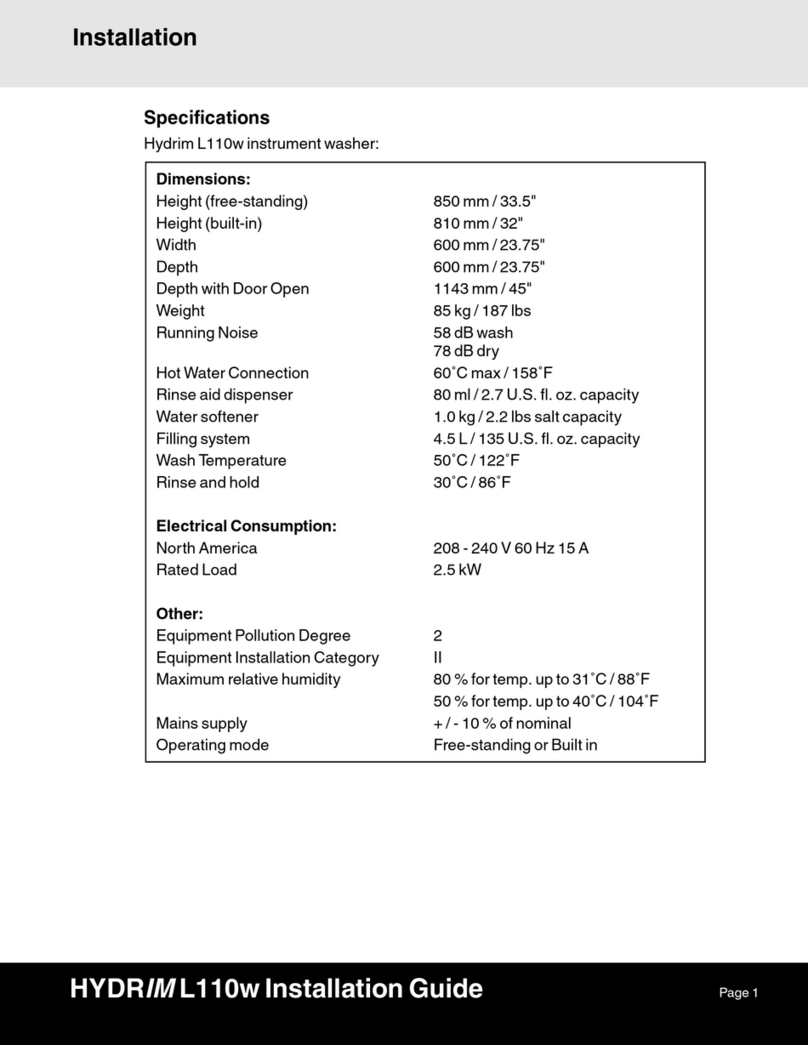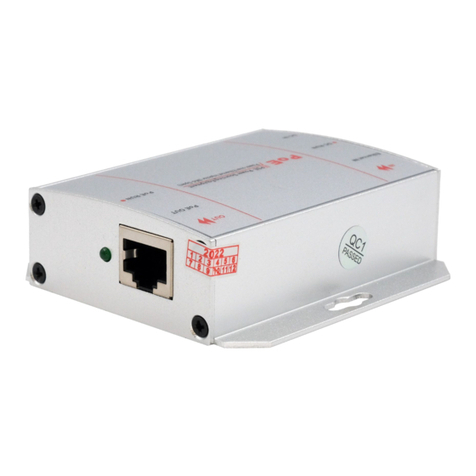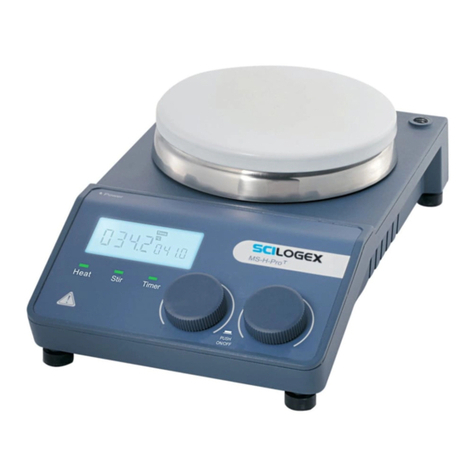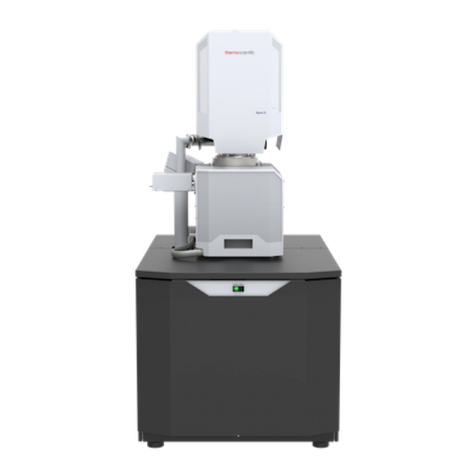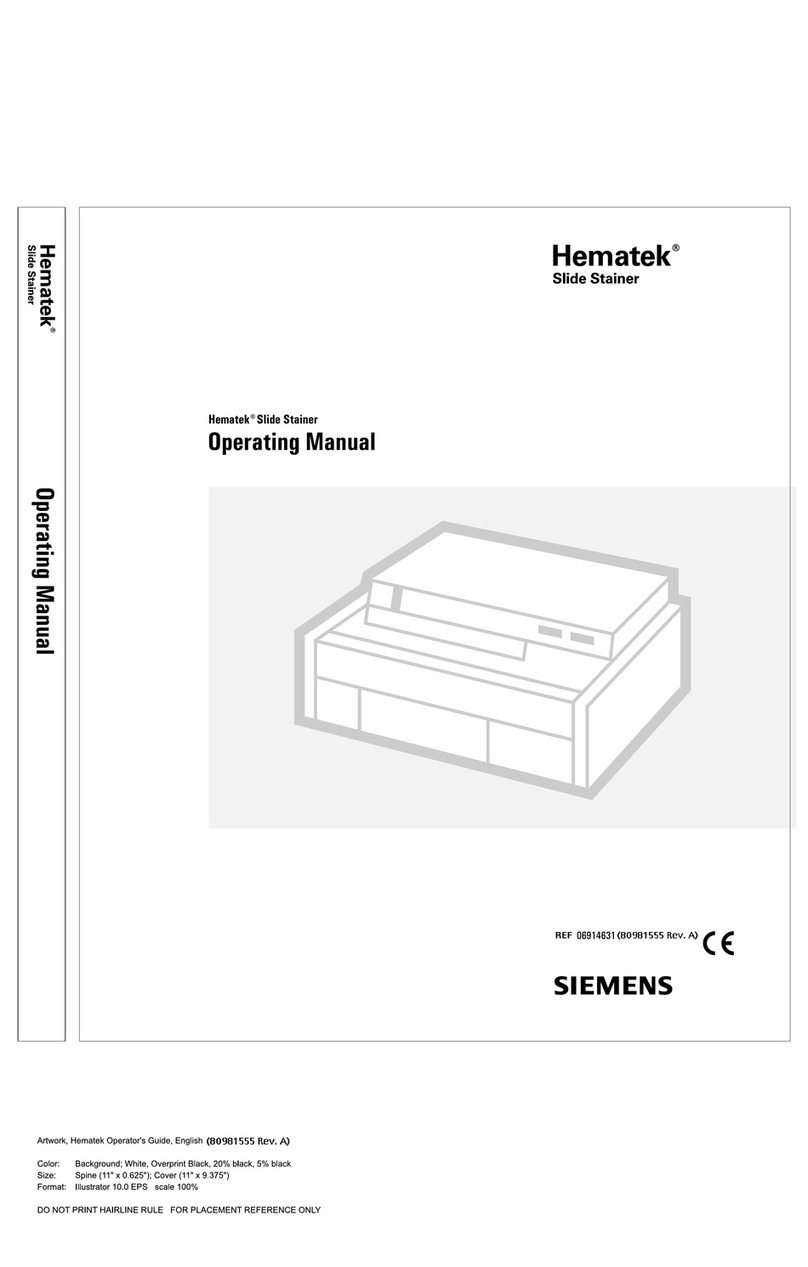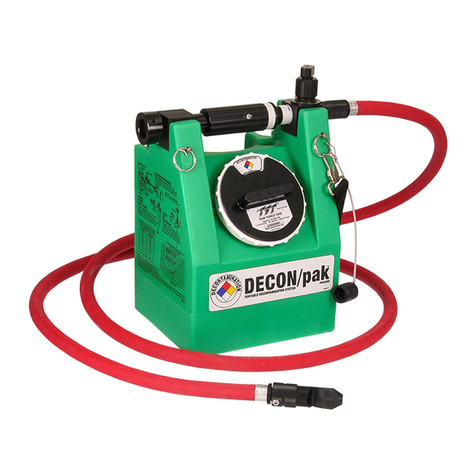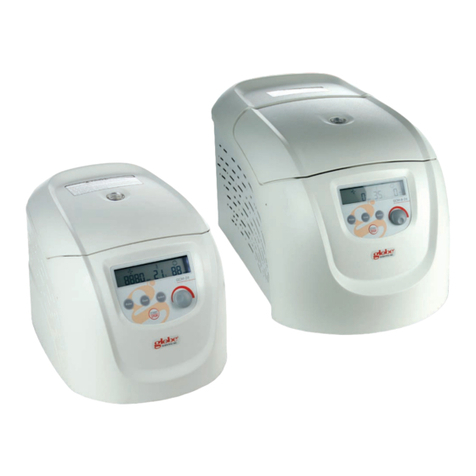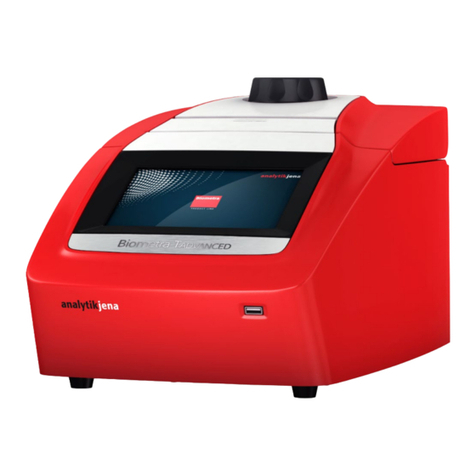Dionex IONPAC AG9-SC GUARD COLUMN User manual

for
IonPac®AG9-SC
IonPac®AS9-SC

IonPacAS9-SC 034656-06 Page 1 of 28
PRODUCT MANUAL
for the
IONPAC®AG9-SC GUARD COLUMN
(4 x 50 mm, P/N 043186)
IONPAC®AS9-SC ANALYTICAL COLUMN
(4 x 250 mm, P/N 043185)
©DIONEX Corporation, 2008
Document No. 034656
Revision 06
November 2008

IonPacAS9-SC 034656-06 Page 2 of 28
TABLE OF CONTENTS
SECTION 1 - INTRODUCTION...................................................................................................... 4
SECTION 2 - THE ION CHROMATOGRAPHY SYSTEM ........................................................ 5
SECTION 3 - INSTALLATION ....................................................................................................... 6
3.1 System Requirements.............................................................................................................................................. 6
3.1.1 System Requirements for 4-mm Operation ............................................................................................................... 6
3.1.2 System Void Volume................................................................................................................................................. 6
3.2 The Sample Concentrator ...................................................................................................................................... 6
3.3 The Injection Loop .................................................................................................................................................. 6
3.3.1 The 4-mm System Injection Loop, 10 - 50 μL......................................................................................................... 7
3.4 The IonPac AG9-SC Guard Column..................................................................................................................... 7
3.5 Installing the Anion Trap Column, ATC-3 .......................................................................................................... 7
3.6 Eluent Storage.......................................................................................................................................................... 8
3.7 The Anion Self-Regenerating Suppressor, ASRS® -ULTRA............................................................................. 8
3.8 The Anion Atlas® Electrolytic Suppressor, AAES............................................................................................. 8
3.9 The Anion MicroMembrane Suppressor, AMMS® III ...................................................................................... 8
3.10 Using AutoRegen® with the ASRS-ULTRA orthe AMMS III in the Chemical Suppression Mode............ 8
3.11 Using Displacement Chemical Regernation (DCR) with the Chemical Suppression Mode........................... 9
3.12 Detector Requirements ........................................................................................................................................... 9
SECTION 4 - OPERATIONS ......................................................................................................... 10
4.1 General Operating Conditions............................................................................................................................. 10
4.2 IonPac AS9-SC Operation Precautions .............................................................................................................. 10
4.3 Chemical Purity Requirements............................................................................................................................ 10
4.3.1 Inorganic Chemicals ................................................................................................................................................ 10
4.3.2 Solvents.................................................................................................................................................................... 10
4.3.3 Deionized Water ...................................................................................................................................................... 11
4.4 Eluent Preparation ................................................................................................................................................ 11
4.4.1 Preparation of Carbonate Eluent Concentrates........................................................................................................ 11
4.4.2 Preparation of Carbonate Eluents ............................................................................................................................ 12
4.4.3 Preparation of Borate Eluents.................................................................................................................................. 12
4.5 The Borate Eluent System .................................................................................................................................... 12

IonPacAS9-SC 034656-06 Page 3 of 28
4.6 Eluents that Contain Solvents .............................................................................................................................. 13
4.7 Regenerant Preparation for the AMMS III ....................................................................................................... 13
4.8 The Sample Concentrator .................................................................................................................................... 14
SECTION 5 - EXAMPLE APPLICATIONS................................................................................. 15
5.1 Production Test Chromatogram.......................................................................................................................... 16
5.2 Inorganic Anions Including Chlorate and Chlorite........................................................................................... 17
5.3 Resolution of Low-Concentration Analytes - EPA Water Matrix ................................................................... 18
5.4 Varying the Eluent System - 22 mM Borate....................................................................................................... 19
5.5 Varying the Eluent System - 10 mM Borate with Column Purge.................................................................... 20
SECTION 6 - TROUBLESHOOTING GUIDE ............................................................................ 21
6.1 High Backpressure ................................................................................................................................................ 21
6.1.1 Finding the Source of High System Pressure .......................................................................................................... 21
6.1.2 Replacing Column Bed Support Assemblies .......................................................................................................... 21
6.2 High Background Or Noise .................................................................................................................................. 22
6.2.1 Preparation of Eluents ............................................................................................................................................. 22
6.2.2 Borate Eluent Precautions ....................................................................................................................................... 22
6.2.3 A Contaminated Guard or Analytical Column ........................................................................................................ 23
6.2.4 A Contaminated Anion Trap Column, ATC-3 ........................................................................................................ 23
6.2.5 Contaminated Hardware .......................................................................................................................................... 24
6.2.6 A Contaminated Anion Self-Regenerating Suppressor, ASRS-ULTRA ................................................................ 24
6.2.7 Contaminated Anion MicroMembrane Suppressor, AMMS III ............................................................................. 25
6.2.8 A Contaminated Anion Atlas Electrolytic Suppressor, AAES............................................................................... 25
6.3 Loss of Front End Resolution............................................................................................................................... 27
6.4 Poor Peak Resolution ............................................................................................................................................ 27
6.4.1 Loss of Column Efficiency...................................................................................................................................... 27
6.4.2 Poor Resolution Due to Shortened Retention Times............................................................................................... 27
6.5 Spurious Peaks....................................................................................................................................................... 27

IonPacAS9-SC 034656-06 Page 4 of 28
Always remember that assistance is available for any problem that may be encountered during the shipment or
operationofDIONEXinstrumentationandcolumnsthroughtheDIONEXNorthAmericaTechnicalCallCenter
at 1-800-DIONEX-0 (1-800-346-6390) or through any of the DIONEX Offices listed in, “DIONEX Worldwide
Offices.”
SECTION 1 - INTRODUCTION
The IonPac® AS9-SC Analytical Column (P/N 043185) is designed for the analysis of inorganic anions including oxyhalides,
such as chlorate, chlorite and bromate.
The 4 x 250 mm IonPac AS9-SC Analytical Column has an ion exchange capacity of approximately 30 μeq/column. This resin
iscomposedofahighly cross-linked(55%)13micronpolyethylvinylbenzene/divinylbenzene substrateagglomeratedwithanion
exchangelatexthathasbeencompletelyaminated.Thelatexhasapolyacrylatebackboneandcarriestheactualionexchangesites.
The IonPac AS9-SC has nominal efficiency for sulfate using standard operating conditions of at least 14,000 plates/meter.
The IonPac AS9-SC can be operated at flow rates up to 3.0 mL/min with eluents that have a pH between 2 and 11. Eluents may
contain organic solvents from 0 - 100% in concentration. Optimally, the IonPac AS9-SC should operate at a backpressure less
than 1,100 psi at 1.0 mL/min. However, the column is capable of operating at backpressures up to 4,000 psi.
CAUTION
Eluent pH must be maintained between 2-11 or irreversible damage to the column will result.
Table 2
AS9-SC/AG9-SC Operating Parameters
Column Typical Back Pressure Standard Maximum
psi (MPa) at 30°C Flow Rate Flow Rate
mL/min mL/min
AS9-SC (4 x 250 mm) Analytical < 950 (6.55) 1.0 3.0
AG9-SC (4 x 50 mm) Guard < 225 (1.55) 1.0 3.0
AS9-SC Analytical Column + Guard <1175 (8.10) 1.0 3.0
Table 1
AS9-SC/AG9-SC Packing Specifications
Column Particle Substrate Latex Latex Column Functional Hydrophobicity
Diameter X-Linking Diameter X-Linking Capacity Group
μm% nm%μeq/column
AS9-SC 13 55 110 20 30-35 Alkyl Medium-low
(4 x 250 mm) quaternary
ammonium
AG9-SC 13 55 110 20 6-7 Alkyl Medium-low
(4 x 50 mm) quaternary
ammonium

IonPacAS9-SC 034656-06 Page 5 of 28
SECTION 2 - THE ION CHROMATOGRAPHY SYSTEM
Table 3
Tubing Back Pressures
Tubing ID
in
H20 Back Pressure
Psi/ft at 1 mL/min
0.005 111.4
0.007 29.0
0.010 7.0
0.012 3.4
CONDITION 4-mm
Eluent Flow Rate 3 mL/min Maximum Flow Rate
SRS Suppressor ASRS-ULTRA (4-mm)
(P/N 053946)
MMS Suppressor AMMS III (4-mm)
(P/N 056750)
AES Suppressor AAES
(P/N 056116)
Injection Loop 10 - 50 µL
System Void Volume Minimize dead volumes. Switching valves, couplers can be
used. Use the GM-2 , GM-3 or recommended gradient
mixers.
Pumps Use the GP40/GP50/IP20/IP25 in Standard-Bore
Configuration.
The GM-3 Gradient Mixer should be used for gradient
analysis on systems other than the GP40/GP50/IP20/IP25
and the DX-300 HPLC Pump.
Detectors AD20/AD25 Cell (10-mm, 9 µL, P/N 049393)
VDM-2 Cell (6-mm, 10 µL) P/N 043113
CD20, CD25, CD25A, ED40, ED50, or ED50A
Conductivity Cell with DS3
P/N 044130 or with shield P/N 044132
CDM-2/CDM-3 Cell P/N 042770
Either the TS-1 with the TS-2 can be used with the CDM-2
or the CDM-3. Do not use the TS-2 or the TS-1 with the
ED40/ED50 or the CD20/CD25.
DIONEX Back Pressure Regulator 75 psi rating (P/N
039760, 046480) or Tubing (see Table 3)
Ensure 50-75 psi back pressure.

IonPacAS9-SC 034656-06 Page 6 of 28
SECTION 3 - INSTALLATION
3.1 System Requirements
3.1.1 System Requirements for 4-mm Operation
TheIonPacAS9-SC4-mmGuardandAnalyticalColumnsaredesignedto berunonthefollowingDIONEXIonChromatographs
equipped with suppressed conductivity detection. Isocratic analyses at flow rates of 0.5 mL/min or greater can be performed on
a GS50/GP50/GP40/IP25, Gradient Pump Module (GPM-2) or an Advanced Gradient Pump (AGP) with standard (1/8" pistons)
pump heads. For isocratic analyses at flow rates below 0.5 mL/min and gradient analyses, a Microbore GS50/GP50/GP40 or
Advanced Gradient Pump (1/16" pistons) must be employed.
3.1.2 System Void Volume
It is important to minimize system void volume. For best performance, all of the tubing installed between the injection valve and
detector should be 0.005" (P/N 044221) ID PEEK tubing, 0.010" ID PEEK tubing (P/N 042260) or 0.012" Tefzel tubing (see,
DIONEX Product Selection Guide). Minimize the lengths of all connecting tubing and remove all unnecessary switching valves
and couplers. If you need assistance in properly configuring your system contact the nearest DIONEX Worldwide Office (see,
DIONEX Worldwide Offices).
3.2 The Sample Concentrator
The Low Pressure Trace Anion Concentrator Column (TAC-LP1, P/N 046026), the Trace Anion Concentrator Column (TAC-2,
P/N043101), the Anion MicroConcentrator, AMC-1, (P/N 051760) or the IonPac AG9-SC 4-mm Guard Column can be used for
trace anion concentration work required in high purity water analysis. The function of the TAC-LP1, the TAC-2, the AMC-1, or
the AG14A Guard Column in these applications is to strip ions from a measured volume of a relatively clean aqueous sample
matrix. This process “concentrates” all anionic analyte species onto the TAC-LP1, TAC-2, AMC-1 or the AG14A leading to a
loweringofdetectionlimitsby2-5ordersofmagnitude.TheuniqueadvantagetotheanalyticalchemistoftheTAC-LP1,theTAC-
2, the AMC-1, or the AG9-SC in these applications is the capability of performing routine trace analyses of sample matrix ions
at µg/L levels without extensive and laborious sample pretreatment.
3.3 The Injection Loop
Table 4
Smallest Injectable Volumes (μL)
Valve Type Using 0.012" ID
Tefzel Tubing Using 0.007" ID
Tefzel Tubing Using 0.010" ID
PEEK Tubing Using 0.005" ID
PEEK Tubing
DIONEX
BF2 Valve
(8 µL Internal Volume)
(10 cm Loop)
15.2 10.5 13.1 9.2
DIONEX
MicroInject Valve
(10.5 µL Internal Volume)
(14 cm Loop)
20.5 14.0 17.6 12.2
Rheodyne
Microinjection Valve
Model 9126
(0.8 µL Internal Volume)
(10 cm Loop)
8.0 3.3 5.9 2.0

IonPacAS9-SC 034656-06 Page 7 of 28
3.3.1 The 4-mm System Injection Loop, 10 - 50 μL
For most applications on a 4-mm analytical system, a 10 - 50 µL injection loop will be sufficient. Generally, do not inject more
than 10 nanomoles (100 - 200 ppm) of any one analyte onto the 4-mm analytical column. Injecting larger volumes of samples
can result in overloading the column which can affect peak efficiency and resolution.
3.4 The IonPac AG9-SC Guard Column
An IonPac AG9-SC Guard Column is normally used with the IonPac AS9-SC Analytical Column. Retention times will increase
by approximately 20% when a guard column is placed in-line prior to the analytical column. A guard is placed prior to the
analytical column to prevent sample contaminants from eluting onto the analytical column. It is easier to clean or replace a guard
columnthan it isananalytical column.Replacingthe AG9-SC GuardColumnat thefirstsign of peakefficiencyloss ordecreased
retention time will prolong the life of the AS9-SC Analytical Column.
3.5 Installing the Anion Trap Column, ATC-3
When performing a gradient anion exchange application, a borate eluent system should be used instead of a carbonate system
because of its low background conductivity. An IonPac Anion Trap Column (ATC-3 (4-mm), P/N 059660) should be installed
between the Gradient Pump and the injection valve. Remove the high pressure Gradient Mixer if present. The ATC is filled with
high capacity anion exchange resin which helps to minimize the baseline shift caused by increasing anionic contaminant levels
in the eluent as the ionic concentration of the eluent is increased over the course of the gradient analysis.
To install the ATC-3 (4-mm), complete the following steps:
A. Remove the Gradient Mixer, if installed between the gradient pump pressure transducer and the injection valve.
B. ConnectthegradientpumpdirectlytotheATC-3.ConnectawastelinetotheATC-3outletanddirectthelinetoawaste
container.
C. Flush the ATC-3 (4-mm) with 200 mL of 70 mM Na2B4O7at a flow rate of 2.0 mL/min.
D. Rinse the ATC-3 with the strongest eluent that will be used during the gradient analysis.
E. After flushing the ATC-3 with eluent, connect the ATC-3 to the eluent line that is connected to the injection valve.
Thebackgroundconductivityofyoursystemshouldbelessthan7µSwhenNa2B4O7isbeingpumpedthroughthechromatographic
systemwiththeASRSin-lineandproperlyfunctioning.Thebaselineshiftshouldbenogreaterthan10µSduringaborategradient
eluent concentration ramp from 0 to 70 mM Na2B4O7. If the baseline shifts are greater than 10 µS, the ATC should be cleaned
using steps A - E above.
The ATC-3 can be flushed, at the end of each operating day, to remove any impurities that may have accumulated on it. This will
minimize periodic maintenance and lost data.
A. Flush the ATC-3 with 30 mL of 70 mM Na2B4O7.
B. Prior to next day use of the chromatographic system, flush the ATC-3 with 30 mL of the strongest eluent used in the
gradient program.
See the Product Manual for the IonPac ATC-3 (P/N 032697) for instructions on cleaning a contaminated Anion Trap Column.

IonPacAS9-SC 034656-06 Page 8 of 28
3.6 Eluent Storage
IonPac AS9-SC columns are designed to be used with borate or bicarbonate/carbonate eluent systems. Storage under a helium
atmosphere ensures contamination free operation and proper pump performance (nitrogen can be used if eluents do not contain
solvents).
3.7 The Anion Self-Regenerating Suppressor, ASRS® -ULTRA
An Anion Self-Regenerating Suppressor should be used for applications that require suppressed conductivity detection. It is
compatible with solvent containing eluents and aqueous ionic eluents of all concentrations with which the systems and columns
are compatible. Aqueous ionic eluents can be used in all ASRS-ULTRA modes of operation.
NOTE
Solvent containing eluents should be used in the AutoSuppression External Water Mode.
If you are installing an IonPac AS9-SC 4-mm Analytical Column, use an ASRS-ULTRA (4-mm, P/N 053946).
For detailed information on the operation of the Anion Self-Regenerating Suppressor, see Document No. 031367, the “Product
Manual for the Anion Self-Regenerating Suppressor-ULTRA, the ASRS-ULTRA.”
3.8 The Anion Atlas® Electrolytic Suppressor, AAES
An Atlas Anion Electrolytic Suppressor (AAES) may be used instead of an ASRS-ULTRA for applications that require
suppressed conductivity detection. The AAES (P/N 056116) can be used for AS9-SC 4-mm applications using eluents up to 25
µeq/min.
For detailed information on the operation of the Atlas Anion Electrolytic Suppressor, see Document No. 031770, the “Product
Manual for the Atlas Anion Electrolytic Suppressor.”
3.9 The Anion MicroMembrane Suppressor, AMMS® III
An Anion MicroMembrane Suppressor, the AMMS III (P/N 056750) can also be used for applications that require suppressed
conductivitydetection.Itiscompatible with all solvents and concentrations with which thesystemsandcolumnsarecompatible.
For detailed information on the operation of the Anion MicroMembrane Suppressor, see Document No.031727, the “Product
Manual for the Anion MicroMembrane Suppressor III, the AMMS III.”
NOTE
Do not run the AMMS III Suppressor over 40°C. If you are using an application where temperatures in excess
of 40°C are required, place the suppressor outside of the oven.
To minimize the baseline shift when performing an analysis that requires a borate gradient, a high regenerant flow rate (10 - 15
mL/min)is required. To save regenerant preparation time and reduce regenerant consumption and waste, DIONEX recommends
using an AutoRegen® Accessory (P/N 039594).
3.10 Using AutoRegen® with the ASRS-ULTRA orthe AMMS III in the Chemical Suppression Mode
Tosaveregenerantpreparationtimeandreduceregenerantconsumption andwaste, DIONEXrecommendsusinganAutoRegen®
Accessory (P/N 039594). For more detailed information on the use of the AutoRegen Accessory see the AutoRegen Accessory
manual(DocumentNo.032853).FormoredetailedinformationontheuseofAutoRegenRegenerantCartridges,seethe“Product
Manual for the AutoRegen Regenerant Cartridge Refills” (Document No. 032852).
When using an AutoRegen System, specific contaminants are continuously removed from the regenerant solution to restore it to
the correct ionic state. It is necessary however to replace the regenerant on a regular basis. If solvents are used in the eluent, ionic

IonPacAS9-SC 034656-06 Page 9 of 28
contaminants from the solvent component of the eluent which are not removed by the Anion AutoRegen Regenerant Cartridge
may slowly accumulate in the regenerant. This results in slowly increasing background conductivity. The rate at which the
background conductivity increases versus the required analysis sensitivity will determine how often the regenerant must be
changed.
It is not necessary to change the Anion AutoRegen Regenerant Cartridge until it is completely expended and a sudden jump to
very high background conductivity is observed.
3.11 Using Displacement Chemical Regernation (DCR) with the Chemical Suppression Mode
DIONEXrecommendsusingtheDisplacementChemicalRegeneration(DCR)Modeforchemicalsuppressionusingsulfuricacid
and the Anion MicroMembrane Suppressor (AMMS III). See the DCR kit manual, Document P/N 031664, for details.
SAFETY
Use proper safety precautions in handling acids and bases.
3.12 Detector Requirements
See Section 2, “The Ion Chromatography System,” for 4-mm system detector, cell and thermal stabilizer requirements.

IonPacAS9-SC 034656-06 Page 10 of 28
SECTION 4 - OPERATIONS
4.1 General Operating Conditions
SampleVolume: 10 µL Loop+0.8µLInjectionvalvedeadvolume
Column: AS9-SC4-mmAnalyticalColumn+AG9-SC4-mmGuardColumn
Eluent: 1.8mMNa2CO3/1.7mMNaHCO3
EluentFlowRate: 1.0mL/min
SRSSuppressor: AnionSelf-RegeneratingSuppressor,ASRS-ULTRA(4-mm)
AutoSuppression Recycle Mode
or MMS Suppressor: AnionMicroMembraneSuppressor,AMMSIII(4-mm)
MMSRegenerant: 50mNH2SO4
or AES Suppressor: Anion Atlas Electrolytic Suppressor, AAES
ExpectedBackgroundConductivity: 15-20µS
Long-termStorageSolution(>1week): 100mMSodiumBicarbonate
Short-termStorageSolution(<1week): Eluent
TheselectivityoftheIonPacAS9-SC4-mmAnalyticalColumnhasbeendesignedtoseparateF-,ClO2-,BrO3-,Cl-,NO2-,Br-,ClO3,
NO3-, HPO42- and SO42- isocratically in less than 10 minutes. The AS9-SC packing is a highly cross-linked (55%), microporous
resinthathas been agglomerated with totallypermeablelatexparticles that are completelyaminated.Thelatexparticles carrythe
actual ion exchange function - an alkanol quaternary ammonium group. The polyacrylic structure of the latex MicroBeads make
theAS9-SCcompatiblewithpH 2-11eluents.Thehighlycross-linkedsubstratecorerenderstheAS9-SCcompatiblewitheluents
containing 0-100% HPLC solvents organic solvents. The AS9-SC can be used with any suppressible ionic eluent that does not
exceed the capacity of the suppressor.
4.2 IonPac AS9-SC Operation Precautions
CAUTION
Filter and Degas Eluents
Filter Samples
Eluent pH between 2 and 11 and contains no hydroxide
Sample pH between 2 and 13
3 mL/min Maximum Flow Rate
4.3 Chemical Purity Requirements
Obtaining reliable, consistent and accurate results requires eluents that are free of ionic impurities. Chemicals, solvents and
deionized water used to prepare eluents must be of the highest purity available. Low trace impurities and low particle levels in
eluents also help to protect your ion exchange columns and system components. DIONEX cannot guarantee proper column
performance when the quality of the chemicals, solvents and water used to prepare eluents has been compromised.
4.3.1 Inorganic Chemicals
ReagentGradeinorganicchemicalsshouldalwaysbeused to prepare ionic eluents. Whenever possible, inorganic chemicals that
meet or surpass the latest American Chemical Society standard for purity should be used. These inorganic chemicals will detail
the purity by having an actual lot analysis on each label.
4.3.2 Solvents
Since solvents used with the IonPac AS9-SC columns are added to ionic eluents to modify the ion exchange process or improve
sample solubility, the solvents used must be free of ionic impurities. However, since most manufacturers of solvents do not test
for ionic impurities, it is important that the highest grade of solvents available be used. Currently, several manufacturers are
making ultrahigh purity solvents that are compatible for HPLC and spectrophotometric applications. These ultrahigh purity

IonPacAS9-SC 034656-06 Page 11 of 28
solventswillusuallyensurethatyourchromatographyisnotaffectedbyionicimpuritiesinthesolvent.CurrentlyatDIONEX,we
have obtained consistent results using High Purity Solvents manufactured by Burdick and Jackson and OPTIMA® Solvents by
FisherScientific.
4.3.3 Deionized Water
The deionized water used to prepare eluents should be Type I Reagent Grade Water with a specific resistance of 18.2 megohm-
cm.Thedeionizedwatershouldbefreeofionizedimpurities,organics,microorganismsandparticulatematterlargerthan0.2µm.
Bottled HPLC-Grade Water (with the exception of Burdick & Jackson) should not be used since most bottled water contains an
unacceptable level of ionic impurities.
4.4 Eluent Preparation
NOTE
Always degas and store all eluents in glass or plastic eluent bottles pressurized with helium. Only helium can be
used to purge and degas ionic eluents containing solvents, since nitrogen is soluble in solvent containing eluents.
The above precautions, if taken when making eluents, ensure smooth, reproducible ramps, with minimum total change in
backgroundconductivitywhenusingsodiumcarbonate/bicarbonate(isocratic) or borate (isocratic and gradient) eluents with the
AS9-SC columns.
The following table details the use of the above eluent types:
Table 5
Eluent Type Selection
Eluent Application
Bicarbonate/Carbonate Isocratic Analysis
Borate Isocratic or Gradient Analysis
Hydroxide DO NOT USE!
4.4.1 Preparation of Carbonate Eluent Concentrates
A. 0.5 M Sodium Carbonate (Na2CO3) Concentrate
1. Order DIONEX P/N 037162 or
2. Thoroughly dissolve 26.49 g of Na2CO3in 400 mL of deionized water with a specific resistance of 18.2 megohm-
cm. Dilute to a final volume of 500 mL.
B. 0.5 M Sodium Bicarbonate (NaHCO3) Concentrate
1. Order DIONEX P/N 037163 or
2. Thoroughlydissolve21.00gofNaHCO3in400mLofdeionizedwaterwithaspecificresistanceof18.2megohm-
cm. Dilute to a final volume of 500 mL.
C. 200 mM Na2CO3/75 mM NaHCO3 (100X)
The standard test eluent can be readily prepared from this 100X concentrate. This eluent concentrate can be
prepared by thoroughly dissolving 21.978 g of sodium carbonate (MW 106.00 g/mole) plus 6.301 g sodium
bicarbonate (MW 84.00 g/mole) in 700 mL of degassed, deionized water with a specific resistance of 18.2
megohm-cm in a 1 L volumetric flask. Dilute to a final volume of 1,000 mL. This solution can be diluted to make

IonPacAS9-SC 034656-06 Page 12 of 28
eluents or can be used as a column regenerant.
D. AS4ASodiumCarbonate/BicarbonateConcentrate(100X)
0.18 M Na2CO3/0.17 M NaHCO3
1. Order DIONEX P/N 039513 or
2. Thoroughly dissolve 19.078 g of Na2CO3and 14.282 g of NaHCO3in 700 mL of deionized water with a
specific resistance of 18.2 megohm-cm. Dilute to a final volume of 1,000 mL.
CAUTION
Do not use hydroxide eluents or hydroxide to adjust the pH of any eluent higher than pH 11 to effect
selectivity changes. Using eluents with pHs greater than 11 may cause irreversible damage to the IonPac
AS9-SC/AG9-SC Columns.
4.4.2 Preparation of Carbonate Eluents
A. Eluent: 2.0 mM Carbonate/0.75 mM Bicarbonate
Make the eluent by pipetting 10.0 mL of the eluent concentrate into a 1 L volumetric flask. (100X concentrate = 200
mM Na2CO3/75 mM NaHCO3.).See Section 4.1, Preparation of Eluent Concentrates for the preparation of the 100 x
eluent concentrate. Use degassed, deionized water with a specific resistance of 18.2 megohm-cm to dilute the
concentrate to a final volume of 1,000 mL.
4.4.3 Preparation of Borate Eluents
A. Eluent : 22 mM H3BO3/22 mM Na2B4O7
Thoroughly dissolve 8.391 g Na2B4O7/10 H2O (MW 381.42 g/mole) plus 1.360 g H3BO3 (MW 61.84 g/mole) in 700
mLdegassed, deionizedwaterwith aspecificresistance of18.2megohm-cm ina1 Lvolumetricflask. Dilutetoa final
volume of 1,000 mL.
B. Eluent Preparation for Gradient Program
1. Eluent : 10 mM H3BO3/10 mM Na2B4O7
Thoroughly dissolve 3.814 g Na2B4O7?10 H2O (MW 381.42 g/mole) plus 0.618 g H3BO3 (MW 61.84 g/mole) in
700mLdegassed,deionized water with a specificresistanceof18.2megohm-cm in a 1 L volumetricflask.Dilute
to a final volume of 1,000 mL.
2. Purge: 50 mM H3BO3/50 mM Na2B4O7
Thoroughly dissolve 19.071 g Na2B4O7?10 H2O (MW 381.42 g/mole) plus 3.092 g H3BO3 (MW 61.84 g/mole)
in 700 mL degassed, deionized water with a specific resistance of 18.2 megohm-cm in a 1 L volumetric flask.
Dilute to a final volume of 1,000 mL.
4.5 The Borate Eluent System
Theborateeluent system givesthesame elution orderontheAS9-SC column asthecarbonate eluent system(seeFigure4, Anion
Separation using 22 mM Borate Eluent). However, the borate anion is a weaker “pusher” ion than carbonate. Therefore a higher
concentration borate eluent is required to provide the same elution times observed with a carbonate eluent system. The major
advantage of the borate system is that early eluting ions (i.e., fluoride, nitrate) can be easily spread out thus improving resolution
simplybyusingamorediluteeluent(seeFigure 5,AnionSeparationusing10mMBorateEluentwithColumnPurgeafterNitrate).
Carbonate eluent systems can also be diluted to produce a similar effect but not as reliably due to carbon dioxide intrusion from
the air. This improvement in resolution is especially beneficial when doing sub-ppm determinations of early eluting ions such as
chlorite and bromate in the presence of high amounts of common anions such as fluoride and chloride.

IonPacAS9-SC 034656-06 Page 13 of 28
4.6 Eluents that Contain Solvents
When mixing solvents with water remember to mix solvent with water on a volume to volume basis. For example, if a procedure
requires an eluent of 90% acetonitrile, prepare the eluent by adding 900 mL of acetonitrile to an eluent reservoir. Then add 100
mL of deionized water to the acetonitrile in the reservoir. Using this procedure to mix solvents with water will ensure that a
consistent true volume/volume eluent is obtained. Premixing water with solvent will minimize the possibility of outgassing.
NOTE
When degassing eluents containing solvents, do not degas the eluent excessively since it is possible that a volatile
solvent can be “boiled” off from the solution.
TheAS9-SCcanwithstandcommonHPLCsolventsinaconcentrationrangeof0-100%.Solventsandwatershouldbepremixed
in concentrations to allow proper mixing by the gradient pump and to minimize outgassing. Ensure that all of the inorganic
chemicalsaresolubleinthehighestsolventconcentrationtobeusedduringtheanalysissothatsaltsdonotprecipitateoutineither
the pump or the column.
Table 6
HPLC Solvents for Use with IonPac AS9-SC Columns
Solvent Maximum Operating
Concentration
Acetonitrile 100%
Methanol 100%
2-Propanol 100%
Tetrahydrofuran 20%
When using a solvent in an ionic eluent, column generated backpressures will depend on the solvent used, concentration of the
solvent, the ionic strength of the eluent and the flow rate used. The column back pressure will vary as the composition of water-
methanol and water-acetonitrile mixture varies.
The practical backpressure limit for the IonPac AS9-SC columns is 4,000 psi. Therefore, any combination of the above,
contributing to operating backpressure that totals up to 4,000 psi, can be used.
4.7 Regenerant Preparation for the AMMS III
The regenerant is 50 mN sulfuric acid. Dilute 100 mL (about 100 g) of 0.50 N sulfuric acid (P/N 037164 or P/N 039601) to 1 L
using deionized water. If you are not using the AutoRegen Accessory (P/N 039594), prepare several liters of the regenerant.
For a guide to properly adjusting the regenerant flow rate, see Document No. 031727, the Product Manual for the Anion
MicroMembrane Suppressor III, the AMMS III.

IonPacAS9-SC 034656-06 Page 14 of 28
4.8 The Sample Concentrator
The Low Pressure Trace Anion Concentrator Column (TAC-LP1, P/N 046026), the Trace Anion Concentrator Column (TAC-2,
P/N043101), the Anion MicroConcentrator, AMC-1, (P/N 051760) or the IonPac AG9-SC 4-mm Guard Column can be used for
trace anion concentration work required in high purity water analysis. The function of the TAC-LP1, the TAC-2, the AMC-1, or
the AG9-SC Guard Column in these applications is to strip ions from a measured volume of a relatively clean aqueous sample
matrix. This process “concentrates” all anionic analyte species onto the TAC-LP1, TAC-2, AMC-1 or the AG9-SC leading to a
lowering of detection limits by 2-5 orders of magnitude.
The concentrator column is used in lieu of the sample loop. Pump the sample onto the concentrator column in the OPPOSITE
direction of the eluent flow. When using concentration techniques, do not overload the concentrator column by concentrating an
excessive amount of sample. Concentrating an excessive amount of sample can result in inaccurate results being obtained. It is
possibleduring the concentration step for the polyvalent anions such as phosphate and sulfate to elute the weakly retained anions
such as fluoride and acetate off the concentrator column.
Foradetaileddiscussionofanionconcentrationtechniques,refertoSection3,Operation,oftheTraceAnionConcentrator(TAC-
2) Column Product Manual (Document No. 034467). For further information on the AMC-1 (P/N 051760) see, Product Manual
for AMC-1 Anion MicroConcentrator Column, Document No. 031262.

IonPacAS9-SC 034656-06 Page 15 of 28
SECTION 5 - EXAMPLE APPLICATIONS
Before attempting any of the following example applications, take the time to ensure that your system is properly configured.
Ensure that all of the eluents have been made from high purity reagents and deionized water. All water used in the preparation
ofeluentsshouldbedegassed,deionizedwater.Forchemicalpurityrequirements,seeSection4.3,ChemicalPurityRequirements.
After running synthetic standards to calibrate your system, you may find that real sample matrices foul your columns. For this
reason it is always advisable to use a guard column to protect the analytical column. If column performance deteriorates and it
is determined that the guard or the analytical column has been fouled, refer to the column cleanup protocols in, Column Care.
If your sample matrices are relatively low in ionic concentration, you may be able to increase the sensitivity of your system by
using sample concentration techniques (see Section 3.2, Sample Concentrator).

IonPacAS9-SC 034656-06 Page 16 of 28
5.1 Production Test Chromatogram
IsocraticelutionofanionsontheIonPacAS9-SCAnalyticalColumnhasbeenoptimizedutilizingacarbonate/bicarbonateeluent.
By using this eluent, mono- and divalent anions, including oxyhalides can be isocratically separated and quantitated in a single
injection. To guarantee that all IonPac AS9-SC (4-mm) Analytical Columns meet high quality and reproducible performance
specification standards, all columns undergo the following production control test.
Sample Loop Volume: 25 µL
Analytical Column: IonPac AS9-SC Analytical Column
Eluent: 2.0 mM Na2CO3/0.75 mM NaHCO3
Eluent Flow Rate: 2.0 mL/min
SRS Suppressor: Anion Self-Regenerating Suppressor, ASRS-ULTRA
AutoSuppression Recycle Mode
or AES Suppressor: Anion Atlas Electrolytic Suppressor, AAES
or MMS Suppressor: Anion MicroMembrane Suppressor, AMMS III
MMS Regenerant: 25-50 mN H2SO4
Expected Background Conductivity: 30µS
Long-term Storage Solution (> 1 week): 100 mM Sodium Bicarbonate
Short-term Storage Solution (< 1 week): Eluent
Analyte mg/L
1. Fluoride 3.0
2. Chlorite 10.0
3. Chloride 6.0
4. Nitrite 15.0
5. Bromide 25.0
6. Chlorate 25.0
7. Nitrate 25.0
8. Phosphate 40.0
9. Sulfate 30.0
Figure 1
Production Test Chromatogram AS90-SC

IonPacAS9-SC 034656-06 Page 17 of 28
5.2 Inorganic Anions Including Chlorate and Chlorite
SeparationandelutionofanionsontheIonPac AS9-SC Analytical Column has been optimized utilizing a carbonate/bicarbonate
eluent. By using this eluent, monovalent and divalent anions can be isocratically separated and quantitated in a single injection.
Thecarbonate/bicarbonatemixtureallowsthestrengthoftheeluent,andthustheselectivityofthesystemtobechangedbyvarying
the HCO3-/CO32- ratio. Furthermore, the suppressor reaction product is carbonic acid (H2CO3) and results in a low background
conductivity (14-18 µS) suitable for isocratic analysis. For samples with similar concentrations of ions, the run time can be
decreased to 1/2 the standard run time by doubling the flow rate. For samples with highly variable concentrations, additional
resolution can be obtained at lower flow rates (see Section 4.4, Resolution of Low-Concentration Analytes).
Sample Loop Volume: 25 µL
Analytical Column: IonPac AS9-SC Analytical Column
Eluent: 1.8 mM Na2CO3/1.7 mM NaHCO3
Eluent Flow Rate: See Chromatogram
SRS Suppressor: Anion Self-Regenerating Suppressor, ASRS-ULTRA
AutoSuppression Recycle Mode
or AES Suppressor: Anion Atlas Electrolytic Suppressor, AAES
or MMS Suppressor: Anion MicroMembrane Suppressor, AMMS III
MMS Regenerant: 25-50 mN H2SO4
Expected Background Conductivity: 12-16 µS
Long-term Storage Solution (> 1 week): 100 mM Sodium Bicarbonate
Short-term Storage Solution (< 1 week): Eluent
Figure 2
Inorganic Anions including Chlorate, Chlorite and Bromate
Flow Rate = 2.0 mL/min
1
2
3
4
56
78
9
10
0510
Minutes
-5
15
μS
10
5
0
Flow Rate = 1.0 mL/min
1
2
3
4
5678
9
10
0 5 10 15 20
-5
15
μS
Minutes
10
5
0
Analyte mg/L
1. Fluoride 1.0
2. Chlorite 5.0
3. Bromate 1.0
4. Chloride 1.5
5. Nitrite 5.0
6. Bromide 15.0
7. Chlorate 15.0
8. Nitrate 15.0
9. Phosphate 20.0
10. Sulfate 25.0

IonPacAS9-SC 034656-06 Page 18 of 28
5.3 Resolution of Low-Concentration Analytes - EPA Water Matrix
The following example demonstrates the separation of sample analytes having highly variable concentrations. Setting the flow
rate at 1.0 mL/min allows for increased resolution of very low concentration analytes such as bromate, chlorite, and chlorate in
the following EPA water matrix sample.
Sample Loop Volume: 100 µL
Analytical Column: IonPac AS9-SC Analytical Column
Eluent: 1.8 mM Na2CO3/1.7 mM NaHCO3
Eluent Flow Rate: 1.0 mL/min
SRS Suppressor: Anion Self-Regenerating Suppressor, ASRS-ULTRA (4-mm)
AutoSuppression Recycle Mode
or AES Suppressor: Anion Atlas Electrolytic Suppressor, AAES
or MMS Suppressor: Anion MicroMembrane Suppressor, AMMS III (4-mm)
MMS Regenerant: 25-50 mN H2SO4
Expected Background Conductivity: 12-16 µS
Long-term Storage Solution (> 1 week): 100 mM Sodium Bicarbonate
Short-term Storage Solution (< 1 week): Eluent
1
2
3
4
567
8
9
10
2
1
0
-1
µS
0510
15 20
Peaks mg/L
1. Fluoride 5.66
2. Chlorite 0.50
3. Bromate 0.20
4. Chloride 45.0
5. Nitrite 0.06
6. Bromide 0.08
7. Chlorate 0.14
8. Nitrate 42.0
9. Phosphate 0.17
10. Sulfate 50.0
Figure 3
EPA Water Matrix

IonPacAS9-SC 034656-06 Page 19 of 28
5.4 Varying the Eluent System - 22 mM Borate
The borate eluent gives the same elution order as the carbonate eluent traditionally used on the IonPac AS9. However, since
theborateanion isa“weaker”eluent ion,higherconcentrationsare requiredtoachievethe sameelutiontime.The advantage
of the borate eluent is increased resolution of early eluting ions.
Sample Loop Volume: 50 µL
Analytical Column: IonPac AS9-SC Analytical Column
Eluent: 22 mM H3BO3/22 mM Na2B4O7
Eluent Flow Rate: 2.0 mL/min
SRS Suppressor: Anion Self-Regenerating Suppressor, ASRS-ULTRA
AutoSuppression Recycle Mode
or MMS Suppressor: Anion MicroMembrane Suppressor, AMMS III
MMS Regenerant: 25-50 mN H2SO4
Expected Background Conductivity: 5-6 µS
Long-term Storage Solution (> 1 week): 100 mM Sodium Bicarbonate
Short-term Storage Solution (< 1 week): Eluent
Figure 4
Anion Separation Using 22 mM Borate Eluent
Analyte mg/L
1. Fluoride 0.5
2. Iodate 0.1
3. Acetate 0.1
4. Formate 0.1
5. Chlorite 1.0
6. Bromate 1.0
7. Chloride 1.0
8. Carbonate -
9. Nitrite 0.7
10. Bromide 2.5
11. Chlorate 2.0
12. Nitrate 2.0
13. Phosphate 2.5
14. Sulfate 3.0
05
10 15
-1
0
1
2
1, 2, 3
4
5
6
7
8
9
10
1112
13
14
This manual suits for next models
3
Table of contents
Other Dionex Laboratory Equipment manuals

Dionex
Dionex DX-120 User manual
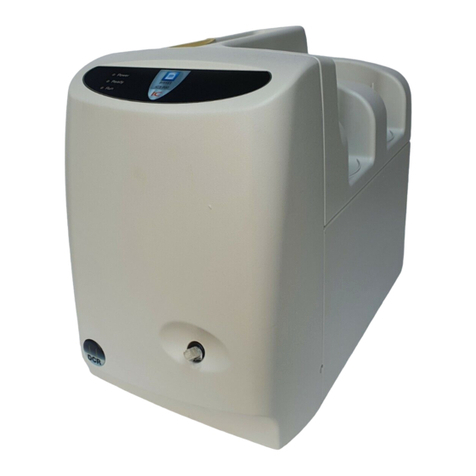
Dionex
Dionex ICS-900 User manual
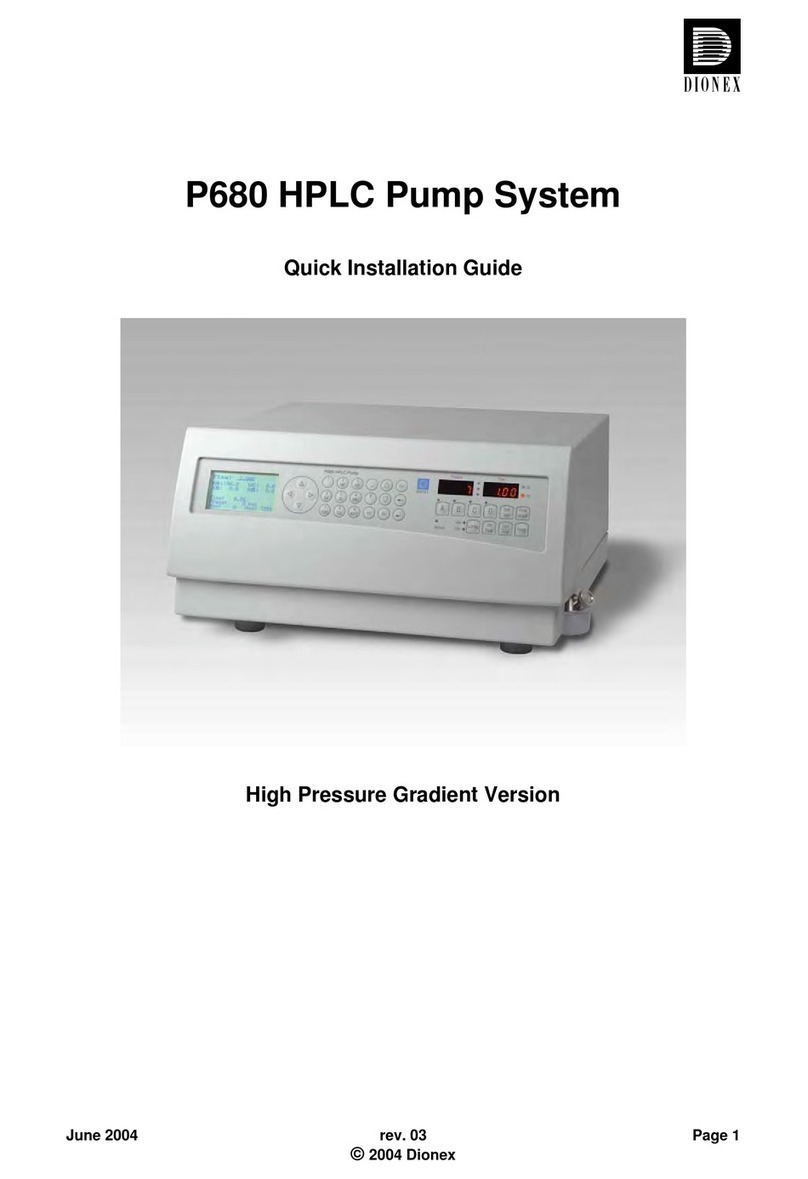
Dionex
Dionex P680 User manual
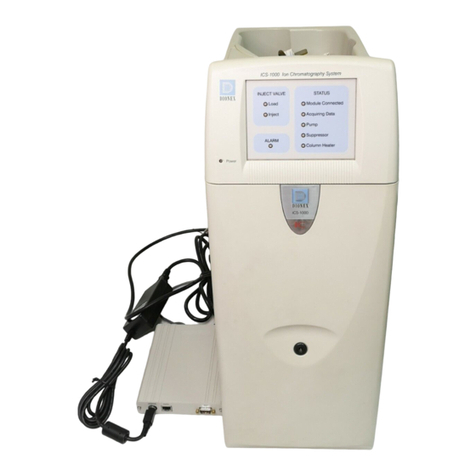
Dionex
Dionex ICS-1000 User manual
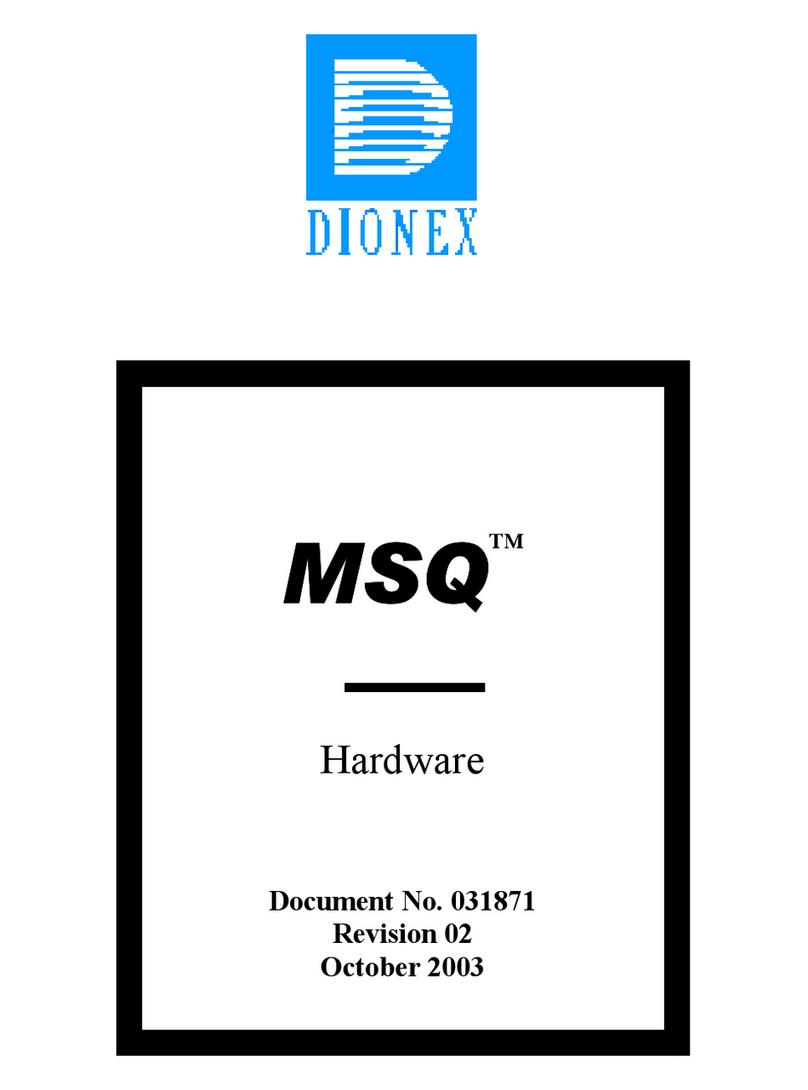
Dionex
Dionex MSQ User manual
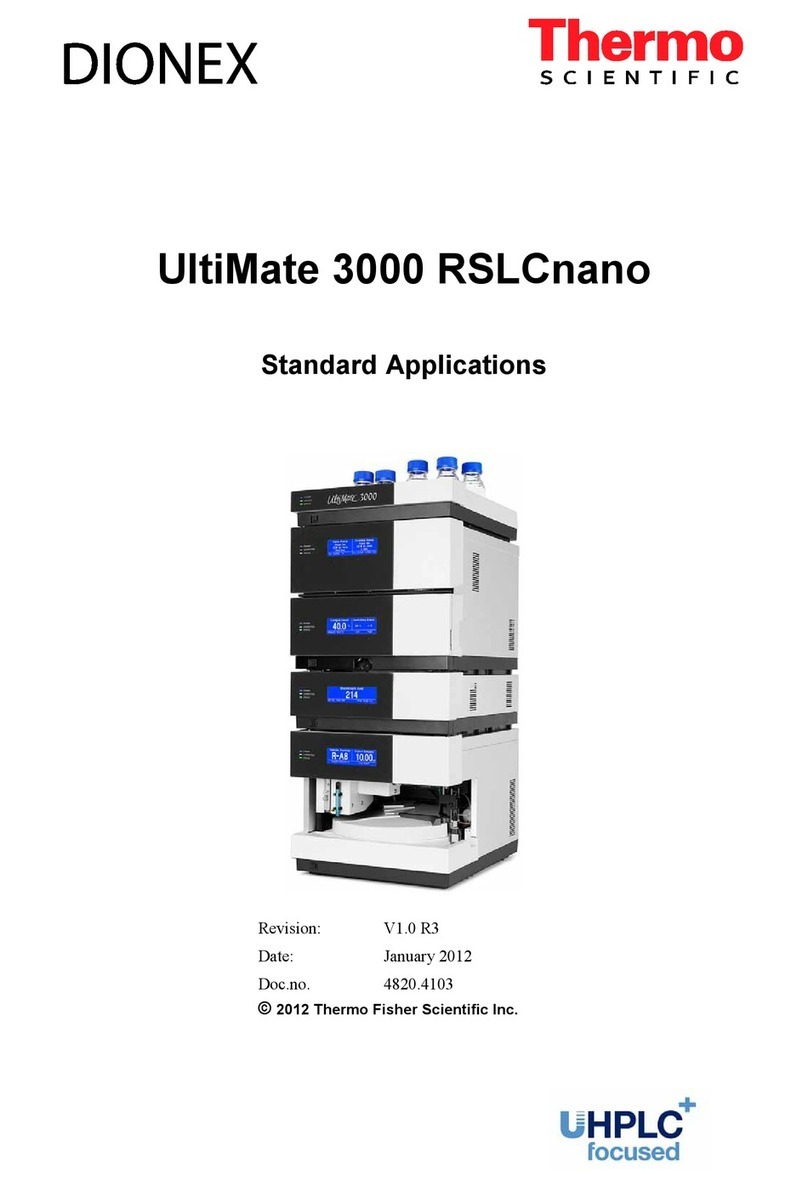
Dionex
Dionex UltiMate 3000 User guide
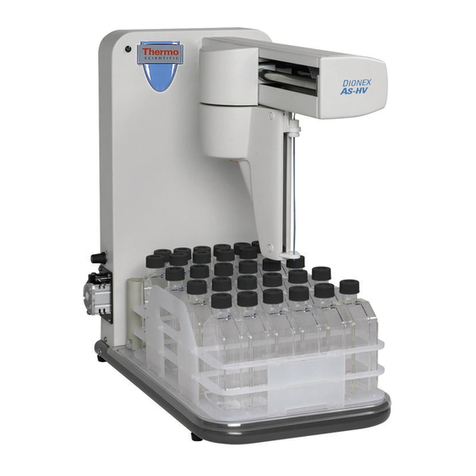
Dionex
Dionex AS-HV User manual

Dionex
Dionex ICS-90 User manual
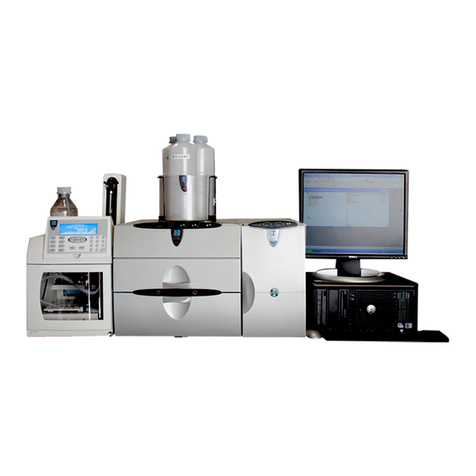
Dionex
Dionex ICS-3000 User manual

Dionex
Dionex UltiMate 3000 User guide
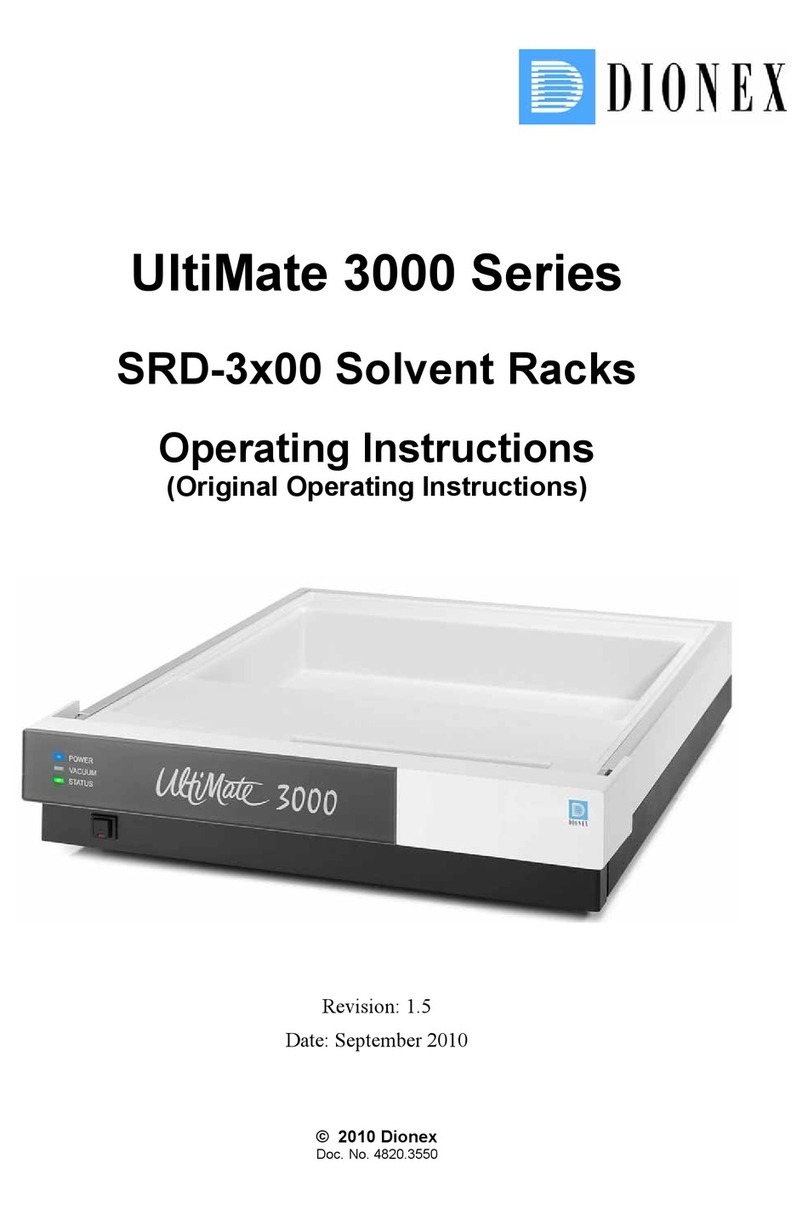
Dionex
Dionex UltiMate 3000 Series User manual
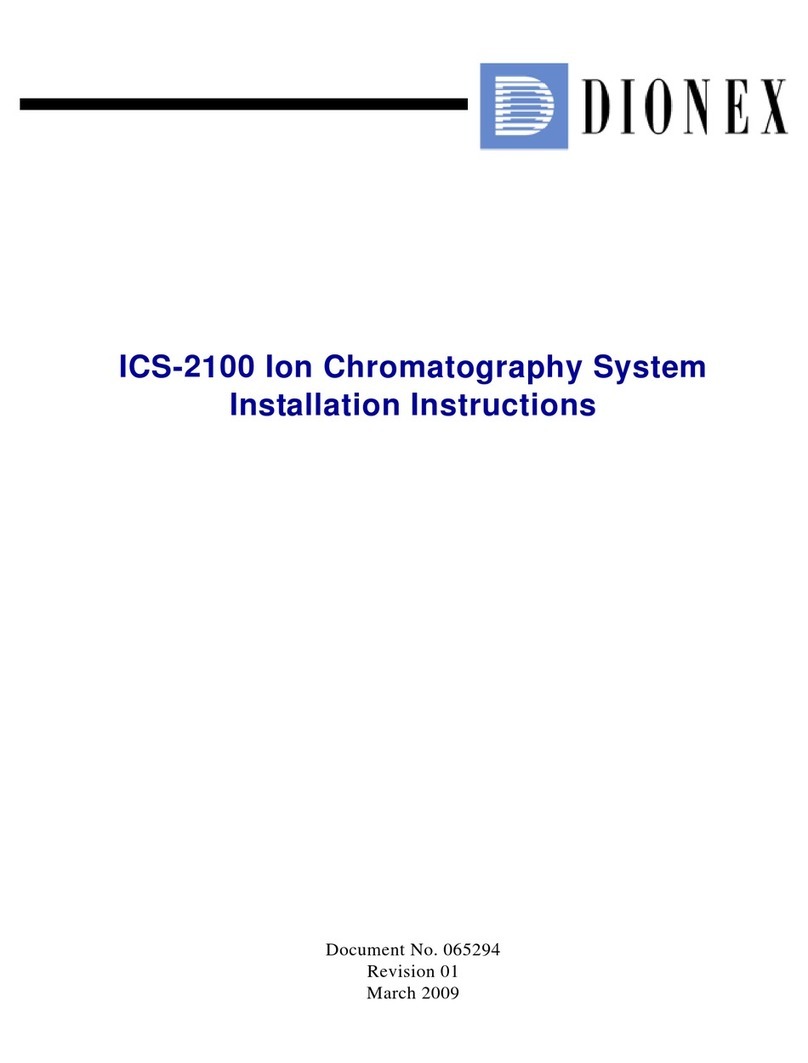
Dionex
Dionex ICS-2100 User manual
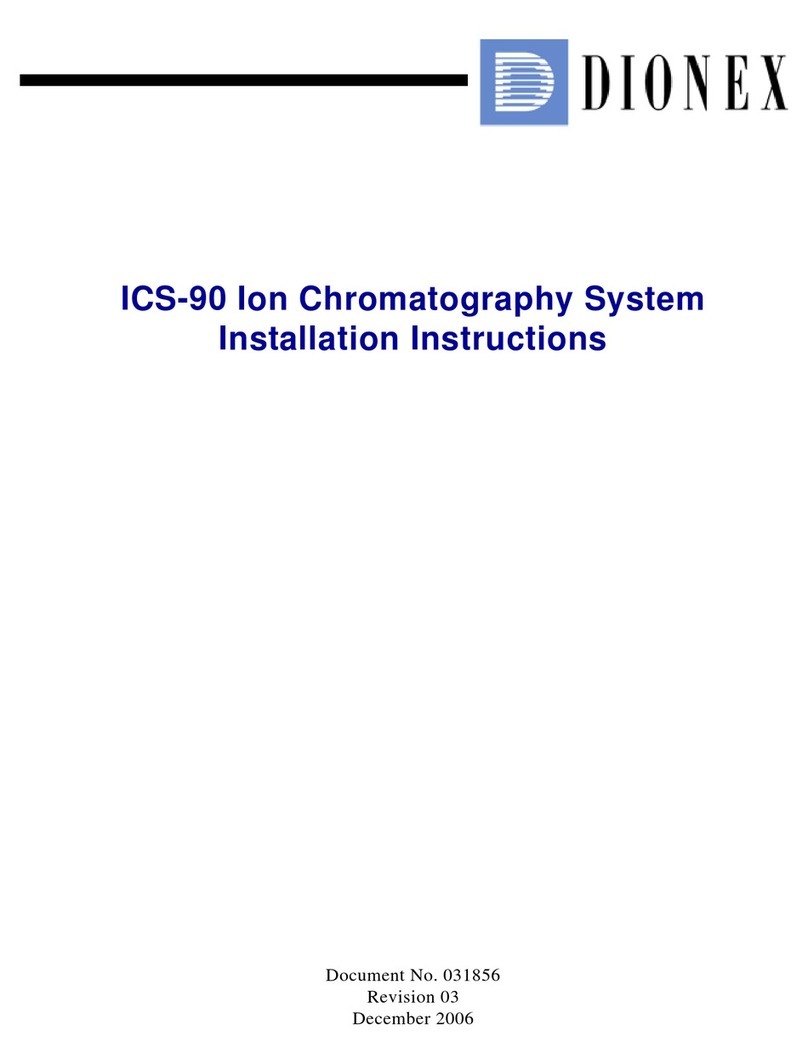
Dionex
Dionex ICS-90 User manual

Dionex
Dionex P680 User manual
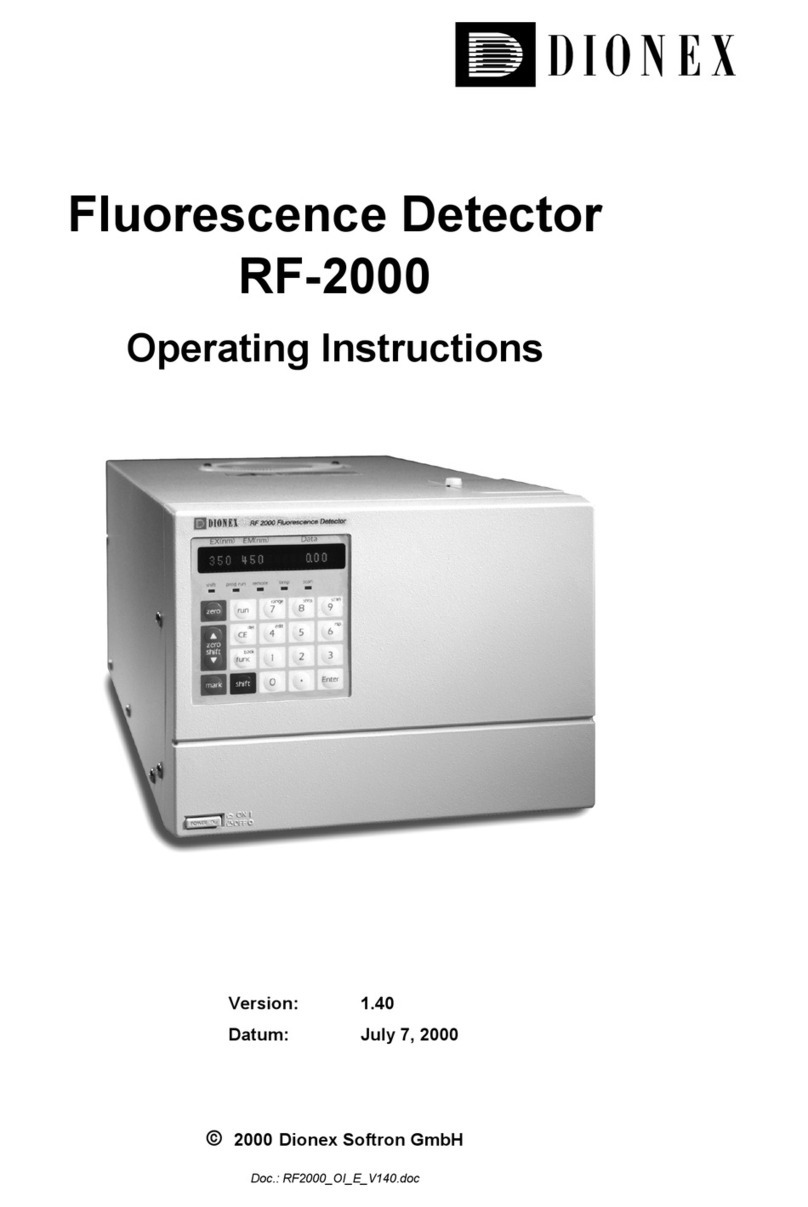
Dionex
Dionex RF-2000 User manual
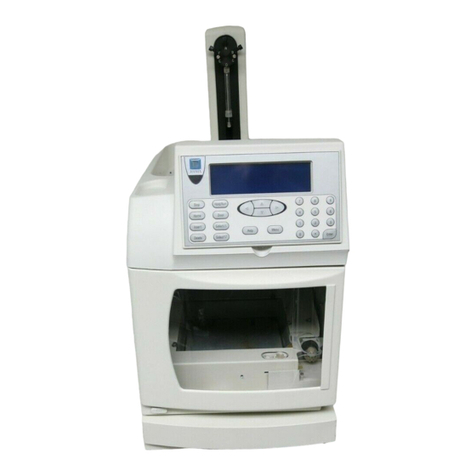
Dionex
Dionex As User manual

Dionex
Dionex P680 User manual
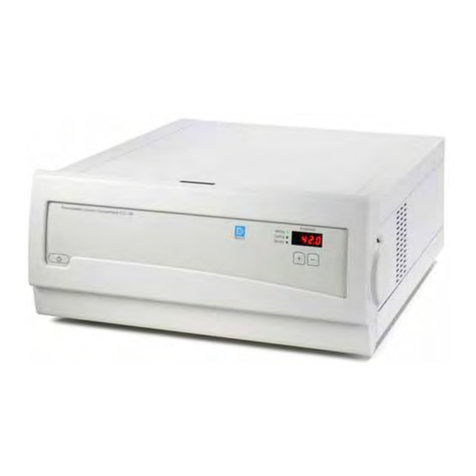
Dionex
Dionex TCC-100 User manual
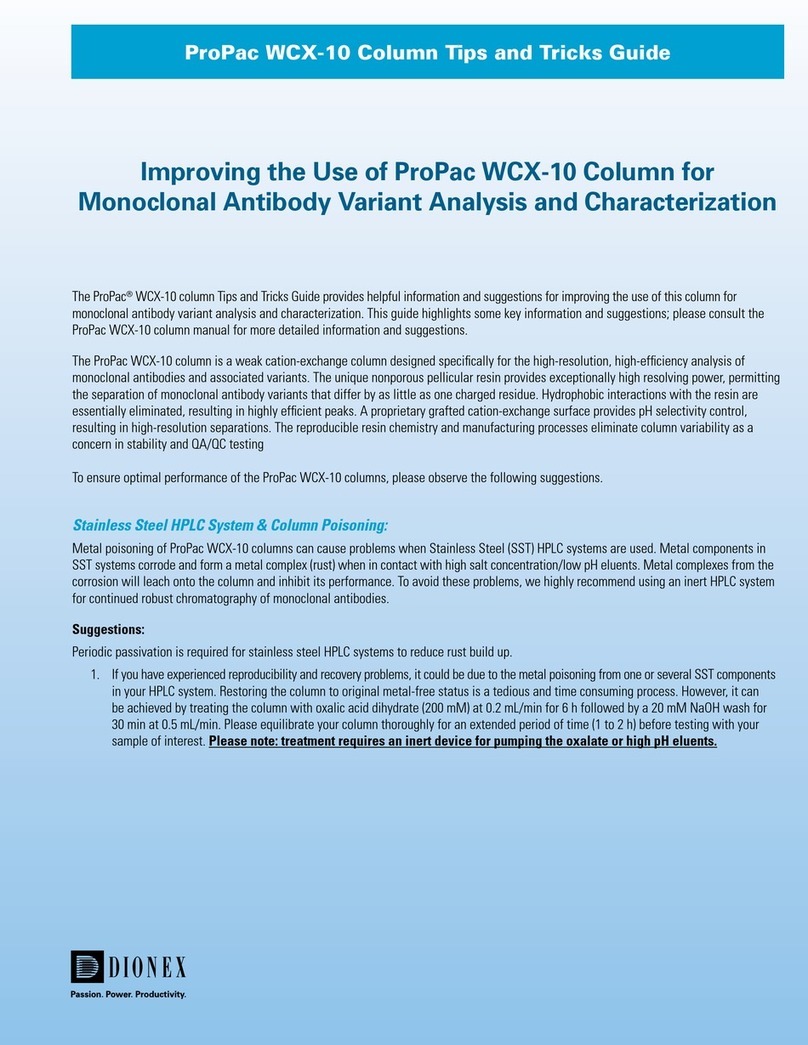
Dionex
Dionex ProPac WCX-10 Assembly instructions

